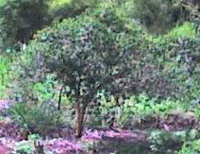|
Hello again; Growing coffee: how we do it! But first, to give you some idea of the way the coffee bush produces the coffee; some "numbers", all rough approximations/averages:- These figures are specifically for MY coffee bushes, grown here, in the Blue Mountains, at 3,500 feet in elevation; and I doubt that the figures would be the same, in any other growing area/region. In a good season, one mature coffee bush will produce some 3,000 cherries, which weigh ( fresh ) 6 pounds, and processes down to 1 pound of, top quality, green beans, or 14 ounces of roasted beans; along with about 3 to 4 ounces of lower grade coffee. It is difficult to be precise, as the coffee is picked 3 times over the season, and to measure the output from a single bush, is almost impossible, so I can only give you an estimate. From seed, it takes 5 ( Geisha ) to 7 years ( Blue Mountain variety ) for a coffee bush to mature, and reach full production: although this can vary a bit; if the growing conditions are exceptionally good whilst the coffee bush is developing; you can deduct a year to 18 months, from these figures. The mature coffee bush is productive for around 25 to 30 years, it can easily live for up to 80 plus years, but produces less fruit as it ages, and they are best replaced in a 25 to 30 year cycle. There are 2 methods of replacing the coffee bushes, the obvious way, dig up the old one, and plant a complete new plant: the second method is used if the roots of the bush are strong and healthy; the whole of the top of the plant is cut off, a few inches above ground level, and several new suckers grow from the roots, all but the 3 strongest ones are cut out, and the 3 remaining shoots left to grow ( if the coffee bush is too old, no new productive suckers grow, in this way, and the whole plant has to be replaced ) this is our preferred method, as the bush will grow very rapidly, and start producing fruit in the second or third year, and will often "mature" in as little as 4 years, as it already has a well developed root mass. There is some disagreement between growers, as to the number of these root suckers to allow to grow from the root stock: it varies between 2 and 4: it is very much dependant on the exact position of the coffee bush, relative to the direction of the sun, and the slope the coffee is growing on. With my plantation facing north-west, and on a steep slope, we use the 3 sucker system on most of the plantation, and only at one end ( where it gets the least sun ) we go for the 2 suckers: at the top/centre of the plantation, we have a patch of 4 sucker bushes, as this is where the plants get the maximum sunshine, throughout the whole day, and the light can reach all sides of the plants. There appears to be very little difference in the amount of coffee the plants produce: the availability of sunshine and water have a far greater effect, than the number of suckers or branches on the coffee bush. [ Note: the Jamaican definition of a "sucker", is any immature plant: and includes English "seedlings", "cuttings" and most pot-plants, that are not in flower: a coffee bush ( or the root suckers ) does not become a "coffee bush" until it produces the first coffee bean. ] The bushes are pruned to keep them between 6 and 8 feet high, for ease of picking, and we try to keep them about 5 feet in diameter, so they don't grow into each other: they should be almost, but not quite, touching. If they are allowed to grow into each other, or have been planted too close together, they obstruct the light from each other, and this results in reduced productivity, and they are far more difficult to pick the ripe beans, from. There are 2 main methods of pruning, we prefer to allow the bushes to grow to just under 8 feet high; the other method is to keep the bush down to about 5 feet high, by continually pruning off the top of the bush, which keeps it lower, and encourages quicker production of the side growing branches, and the coffee bush reaches maximum production a year or two faster than the taller ones: the down-side, is that the total annual production of cherries, is a bit lower; a case of "balancing the options". If the seedling is planted out, at an angle of 45 degrees to the land, it will produce a number of vertically growing branches, from just above the roots, some of these branches are cut off, to leave 2, 3, or 4 of them to grow ( more than 4 and they interfere with each other, less than 2, and the full potential of the bush is never reached ) Over a couple of years the angle at which the bush was planted, is no longer visible, and from the root-base there are the 2 or 3 vertically growing branches, this method slows down the maturation of the coffee bush, but in the long run it does maximise the coffee crop. [ I have tried, and failed, to find an example that comes out on a photograph ] Left totally alone ( wild? ) and in an open area: a coffee seed will grow into a cross between a tree and a bush:-
If coffee is grown in shade, amongst trees, it is most important to prune the shade trees to allow sufficient sunlight to reach the coffee, and ensure that there is plenty of air moving around them: the type of shade tree is also important, some of the trees will suck up all the water and nutrients from the soil, leaving little for the shallower rooted coffee bushes. To be continued ... Best wishes to all, my readers. Robin Plough, friend of www.coffee4dummies.com For questions about JBM, mail to: Этот e-mail адрес защищен от спам-ботов, для его просмотра у Вас должен быть включен Javascript |
Growing Coffee. Part 1
Growing Coffee. Part 1


 A single trunk growing from the ground, and many side branches growing from it: if the plant is growing in the open, it has a short main trunk, and many low side branches: if growing in the "bush", and competing with many other plants, it will grow a longer trunk, to get the leaves as high up, into the light, as possible, before it starts to produce the side branches. Coffee is not a shade-loving plant, it much prefers full sunlight: shade growing is a method of reducing the sunlight available, and slowing down the ripening of the fruits, which gives the coffee a far superior flavour.
A single trunk growing from the ground, and many side branches growing from it: if the plant is growing in the open, it has a short main trunk, and many low side branches: if growing in the "bush", and competing with many other plants, it will grow a longer trunk, to get the leaves as high up, into the light, as possible, before it starts to produce the side branches. Coffee is not a shade-loving plant, it much prefers full sunlight: shade growing is a method of reducing the sunlight available, and slowing down the ripening of the fruits, which gives the coffee a far superior flavour.


